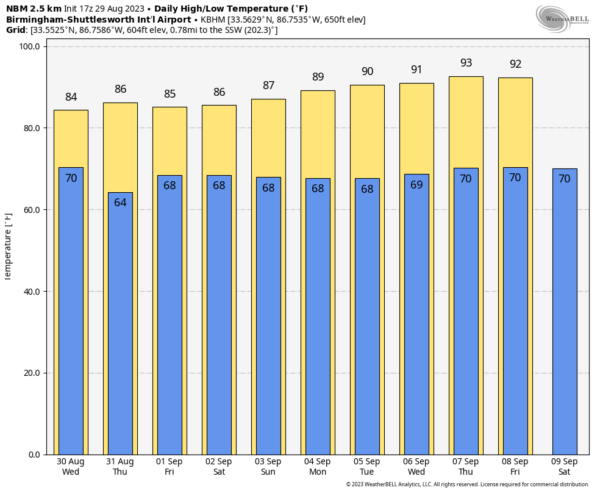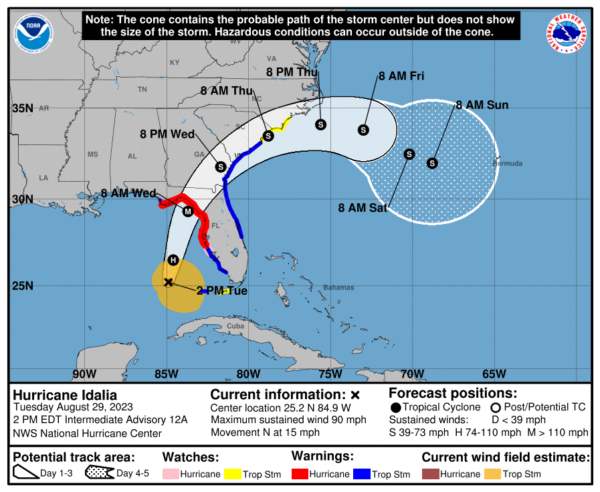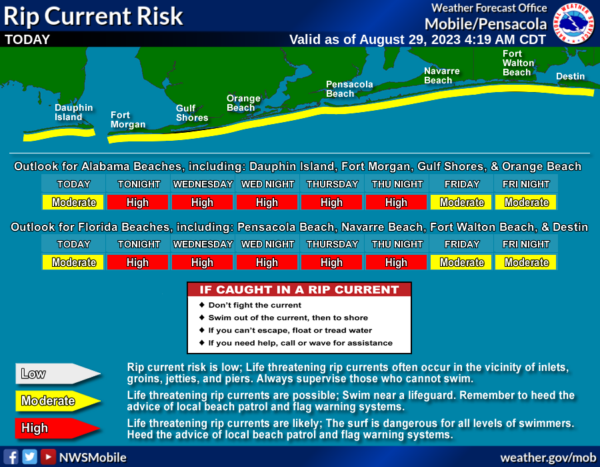Idalia Makes Landfall Tomorrow Morning; Drier Air For Alabama Thursday/Friday
RADAR CHECK: Scattered showers and storms continue to develop across Alabama this afternoon; they are most numerous over the southeast counties of the state. Storms are producing heavy rain and lots of lightning as they move slowly northward. We will maintain the chance of a few showers and storms tonight in the very humid air across Alabama.
There most widespread rain tomorrow will be over Southeast Alabama as Hurricane Idalia moves inland and passes through North Florida and southern Georgia. It will be windy there as well; places like Dothan and Ozark could see winds gusting to 40 mph. For the rest of the state, the day will feature a mix of sun and clouds with just a few widely scattered showers. Highs will be mostly in the 80s.
REST OF THE WEEK: Thursday and Friday will be dry with sunny days, lower humidity, and cooler nights. Some of the cooler spots across North Alabama will dip into the 50s early Thursday morning. Highs will stay in the mid to upper 80s over the northern counties, with low 90s to the south.
LABOR DAY WEEKEND: Dry weather continues with mostly sunny days and fair nights through Monday. Highs for North Alabama will be in the 87-91 degree range, with low to mid 90s for the southern quarter of the state.
NEXT WEEK: The weather continues to look quiet through the rest of next week with only isolated afternoon showers as the upper ridge rebuilds; highs will be mostly in the low to mid 90s. See the video briefing for maps, graphics, and more details.
IDALIA: Hurricane Idalia, with winds of 90 mph, is about 200 miles southwest of Tampa this afternoon, and is moving to the north at 15 mph.
Some key points…
*A hurricane warning remains in effect from Indian Pass to Longboat Key, including Tampa Bay.?
* Confidence is increasing that Idalia will reach the coast of Florida adjacent to Apalachee Bay tomorrow morning, with all of the reliable deterministic track models honed in on that area.
*Idalia is currently over a maximum of oceanic heat content associated with the Loop Current, and water temperatures remain 30-31 degrees Celsius along the forecast path up until landfall. Vertical shear is also expected to be low for the next 18-24 hours, and these conditions are expected to foster rapid intensification before Idalia reaches the coast of Florida. The new NHC intensity forecast indicates a peak intensity of 125 mph just before landfall.
*Catastrophic impacts from storm surge inundation of 10 to 15 feet above ground level and destructive waves are expected somewhere between Aucilla River and Yankeetown, Florida. Life-threatening storm surge inundation is likely elsewhere along portions of the Florida Gulf Coast where a Storm Surge Warning is in effect. Residents in these areas should follow any advice or evacuation orders given by local officials.
*There is the potential for destructive life-threatening winds where the core of Idalia moves onshore in the Big Bend region of Florida, with hurricane conditions expected elsewhere in portions of the Hurricane Warning area along the Florida Gulf Coast. Strong winds will also spread inland across portions of northern Florida and southern Georgia near the track of the center of Idalia where Hurricane Warnings are in effect. Residents in these areas should be prepared for long-duration power outages.
*Areas of flash and urban flooding, some of which may be locally significant, are expected across portions of the west coast of Florida, the Florida Panhandle, and southern Georgia through tomorrow, spreading into portions of the eastern Carolinas tomorrow into Thursday.
*Dangerous rip currents are likely across the central Gulf Coast through Thursday (Gulf Shores to Panama City Beach).
The forecast could still change, so as always watch for updates. When it comes to tropical systems, if you are working with old information, you are working with bad information.
FRANKLIN: Hurricane Franklin is in the Atlantic with winds of 125 mph…. it will pass north of Bermuda tonight, then it heads into the North Atlantic where it will become post-tropical this weekend.
TD 11: Newly formed Tropical Depression Eleven is in the open Atlantic; it is a junk system that won’t last long and won’t impact any land mass.
ON THIS DATE IN 2005: Hurricane Katrina made landfall as a category three storm over Southeast Louisiana and Mississippi. The majority of the loss of lives in Hurricane Katrina was due to flooding caused by fatal engineering flaws in the flood protection system, specifically the levee, around the city of New Orleans. Eventually, 80% of the city, as well as large areas in neighboring parishes, were flooded for weeks. The flooding also destroyed most of New Orleans’s transportation and communication facilities, leaving tens of thousands of people who did not evacuate the city prior to landfall with little access to food, shelter, and other basic necessities.
The coast of Mississippi suffered severe damage from wind and storm surge. The death toll was 1,836 as a direct result of Katrina.
Look for the next video briefing here by 6:00 a.m. tomorrow…
Category: Alabama's Weather, ALL POSTS, Weather Xtreme Videos




















